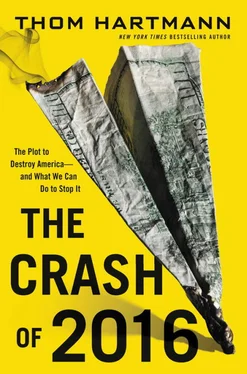Then, go after the textbooks. “The staff of scholars,” Powell wrote, “should evaluate social science textbooks, especially in economics, political science and sociology… This would include assurance of fair and factual treatment of our system of government and our enterprise system, its accomplishments, its basic relationship to individual rights and freedoms, and comparisons with the systems of socialism, fascism and communism.” 38
Powell argued that the civil rights movement and the labor movement were already in the process of rewriting textbooks. “We have seen the civil rights movement insist on re-writing many of the textbooks in our universities and schools. The labor unions likewise insist that textbooks be fair to the viewpoints of organized labor.” 39Powell was concerned the Chamber of Commerce was not doing enough to stop this growing progressive influence and replace it with a pro-plutocratic perspective.
“Perhaps the most fundamental problem is the imbalance of many faculties,” Powell then pointed out. “Correcting this is indeed a long-range and difficult project. Yet, it should be undertaken as a part of an overall program. This would mean the urging of the need for faculty balance upon university administrators and boards of trustees.” 40As in, the Chamber needs to infiltrate university boards in charge of hiring faculty to make sure only corporate-friendly professors are hired.
But Powell’s recommendations weren’t exclusive to college campuses; he targeted high schools as well. “While the first priority should be at the college level, the trends mentioned above are increasingly evidenced in the high schools. Action programs, tailored to the high schools and similar to those mentioned, should be considered,” he urged. 41
Next, Powell turned the corporate dogs on the media. As Powell instructed, “Reaching the campus and the secondary schools is vital for the long-term. Reaching the public generally may be more important for the shorter term.”
Powell added, “It will… be essential to have staff personnel who are thoroughly familiar with the media, and how most effectively to communicate with the public.”
He then went on to say that same system used for the monitoring of college textbooks should be applied to television and radio networks. “This applies not merely to so-called educational programs… but to the daily ‘news analysis’ which so often includes the most insidious type of criticism of the enterprise system.”
Powell didn’t know it yet, but somebody in the Nixon administration was already on the same page as him when it came to injecting Royalist ideology into the media.
The GOP TV Memo and Roger Ailes
Today, Roger Ailes is the chairman of Fox News (he literally goes by the name of “The Chairman”). He, alongside his boss Rupert Murdoch, is one of the most influential newsmen in America—even though what he pushes can hardly be considered “news.” And like any good foot soldier of the Economic Royalists, he runs an extremely lucrative enterprise.
But the profitability of Fox News pales in comparison to its influence on the political landscape in America—and we can thank Roger Ailes for that. In fact, Roger Ailes has been the man behind the curtain at virtually every watershed moment in the Royalist resurgence in America.
Rolling Stone writer Tim Dickinson notes, “As a political consultant, Ailes repackaged Richard Nixon for television in 1968, papered over Ronald Reagan’s budding Alzheimer’s in 1984, shamelessly stoked racial fears to elect George H. W. Bush in 1988, and waged a secret campaign on behalf of Big Tobacco to derail health care reform in 1993.” 42
While working in the Nixon White House in 1970, Roger Ailes enthusiastically supported an idea known as “GOP TV.”
This plan for the Republican/Royalist takeover of television was largely unknown until recently, when investigative reporter John Cook uncovered a cache of documents from the Richard Nixon Presidential Library. One of those documents, a memo titled “A Plan for Putting the GOP on TV News” outlines in great detail how the Nixon administration could subvert television news and get their Republican-friendly message out across America. It’s unclear who originally wrote the document, but Roger Ailes’s personal handwriting is all over the margins with his input on how to get “GOP TV” up and running.
The memo begins by noting a substantial change in where Americans are getting their news. “Television news is watched more often… than people read newspapers, than people listen to radio, than people read or gather any other form of communication,” reads the memo. 43
On the margins, Ailes hammers home the point, writing, “44% say TV is more believable than any other medium.”
What comes next in the memo is a purpose statement, reading, “Purpose—To provide pro-Administration videotape, hard new actualities to the major cities of the United States,” followed by an actual business proposal, complete with estimated costs of production equipment, news crews, and a fancy “customized” editing and delivery truck.
Under a section entitled “The Plan—TV News Operation,” the memo details exactly how GOP TV would work. It goes something like this: A Republican politician in Washington, DC, would record a message for their constituents—dishing out their talking points on whatever hot-button issue Congress is focusing on that week.
Next, that message would be edited down to fit into the “crammed” television news environment and duplicated. Here’s where the GOP TV truck was necessary. In order to save time, all the video would be edited down in the truck after the shoot as the truck was driving to Washington National Airport to immediately freight the TV reels out to local news affiliates around the country to air that night. The memo estimated the entire process could be done in “four to eight hours.”
This was before satellite TV distribution existed, so the plan envisioned in the GOP TV memo was essentially the only way to execute rapid-response Republican messaging on a national scale.
All in all, “GOP TV” came with the fairly hefty price tag of $375,000 for all the equipment plus another $167,000 for a year’s worth of operating costs. Ailes surmised in his notes on the memo that the White House or the Republican National Committee could foot the costs.
At the end of the memo, Ailes makes a pitch for his production company in New York to run GOP TV. He writes, “We would as a production company like to bid on packaging the entire project. I know what has to be done… If you are interested I’ll have my N.Y office put together a) 90 day pilot costs b) cost to continue on annual basis.” Ailes signs off on the memo with, “Best Regards, Roger.”
This memo—the blueprint for instilling Royalist ideology into our nation’s news media—was discovered toward the end of 2010, just as Fox News was enjoying unprecedented success and influence in steering the national political debate toward Republican aims, giving that party an enormous victory in the 2010 midterm elections. The memo garnered little news attention around the nation.
But the meteoric rise of Fox News and the realization of Roger Ailes’s vision of GOP TV cannot be attributed to Richard Nixon’s White House, because Nixon’s people ultimately rejected the idea—citing concerns that it wasn’t economically “feasible.”
But thanks in part to the Powell Memo, a generation later there’d be a lot of financial backing for Royalist media, just as Ailes envisioned it.
The Courts and the Capitol
Subverting the national education system and media were necessary for the long-term seduction of the American people by the Economic Royalists. But for immediate change, Powell saw an opportunity in the courts and on Capitol Hill.
Читать дальше












